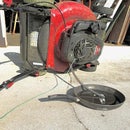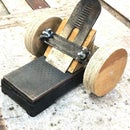Introduction: Make Center Drilling of a Rod Easy
I often use a short piece of 3/8 inch rod as a collar to make a stop end for a 3/16 inch axle in my projects. I have too much difficulty drilling a centered hole in the 3/8 inch rod. I made an accessory for keeping a hole centered without difficulty.
Materials
- 3/4 inch rod
Tools
- Vise
- Drill press
- Drills
- Drill press vise
- Grinder with cutting wheel
- Grinder a stone wheel
Step 1: Cut Stock
I cut a piece of 3/4 inch rod about an inch long. It came from a piece of exercise equipment I found on the curb waiting for garbage pickup. I tried to cut it as squarely as possible. I ground rough edges away after cutting.
Step 2: Drill
I put the 3/4 inch rod into a drill press vise and centered a pilot hole as best I could. Although it appeared my hole would be centered, it drifted a little. I drilled a 3/8 inch hole half the length of the 3/4 inch rod.
Step 3: Drill Again
The beveled center at the bottom of the 3/8 inch hole automatically centers a 3/16 inch drill. I drilled through the rest of the length of the 3/4 inch rod with the 3/16 inch drill.
Step 4: Use
Place the accessory on the end of a 3/8 inch rod.
Step 5: Drill
Put a 3/16 inch drill into an electric drill. Put a few drops of oil into the 3/16 inch hole and begin drilling. All that is necessary is to get a good start on a hole, the remainder of the hole can be drilled by hand without the accessory.
Step 6: Ready to Use
Saw a short section from the end of the 3/8 inch rod. Slip it onto the end of a piece of 3/16 inch rod and weld the collar in place.











